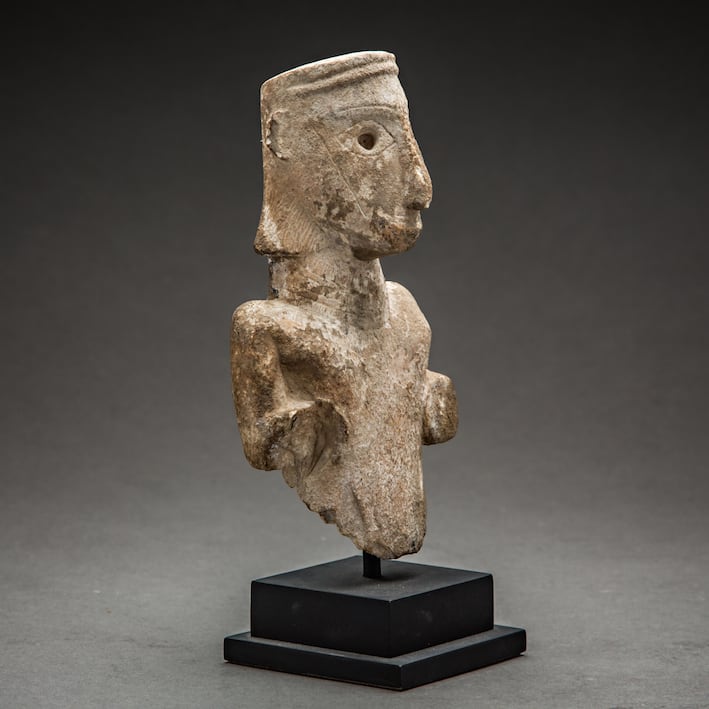Sabean Idol of the Lady of ad-Dali, 100 BCE - 100 CE
Alabaster
18 x 10 cm
7 1/8 x 4 in
7 1/8 x 4 in
LO.549
Further images
This bust was originally part of an idol of a goddess, identifiable by her diadem which is designed as two concentric circles as well as by her multi-stranded necklace consisting...
This bust was originally part of an idol of a goddess, identifiable by her diadem which is designed as two concentric circles as well as by her multi-stranded necklace consisting of a series of beads. She would have originally been shown standing with her feet together on an integral plinth which may have been inscribed. In keeping with concerns for modesty, the forms of her breasts are suppressed. Her arms are bent at a right angle at the elbow and held out in front of her body giving one the impression that she was holding an attribute of some kind in her hands. Her hair is coiffed in a style popular among Sabaean depictions of women and pulled back behind the ears, giving the impression of being closely cropped, and gathered at either side of the neck in projecting triangularly-shaped tresses. The scored lines on her cheeks are to be regarded within the context of her hairstyle. Incisions have also been employed to articulate her eyebrows and eyes. The eyes are now hollow but were originally inlaid and would have imbued the idol with a certain degree of majesty.
The design and style of this idol strongly resemble a limestone statuette discovered in the Shuka necropolis of Yemen which is presently in the National Museum of Aden. The excavators named that idol “the Lady of ad-Dali,” and Barakat’s idol is a second example of this type. One prefers to identify such images as idols of goddesses worshipped by the Yemeni tribesmen who controlled the trade routes, but one cannot exclude the possibility that the statuette represents an elite member of that society. It is important to stress that the Sabaean Culture, which flourished in the southwestern quadrant of the present Arabian Peninsula, is the traditional homeland of the Queen of Sheba. Such an image is a lasting reminder of the realm of that great queen and her legendary wealth.
Reference:
St. John Simpson, Queen of Sheba. Treasures from Ancient Yemen [exhibition catalogue] (London 2002), page 119, figure 130, for the Lady of ad-Dali.
The design and style of this idol strongly resemble a limestone statuette discovered in the Shuka necropolis of Yemen which is presently in the National Museum of Aden. The excavators named that idol “the Lady of ad-Dali,” and Barakat’s idol is a second example of this type. One prefers to identify such images as idols of goddesses worshipped by the Yemeni tribesmen who controlled the trade routes, but one cannot exclude the possibility that the statuette represents an elite member of that society. It is important to stress that the Sabaean Culture, which flourished in the southwestern quadrant of the present Arabian Peninsula, is the traditional homeland of the Queen of Sheba. Such an image is a lasting reminder of the realm of that great queen and her legendary wealth.
Reference:
St. John Simpson, Queen of Sheba. Treasures from Ancient Yemen [exhibition catalogue] (London 2002), page 119, figure 130, for the Lady of ad-Dali.
25
of
25





